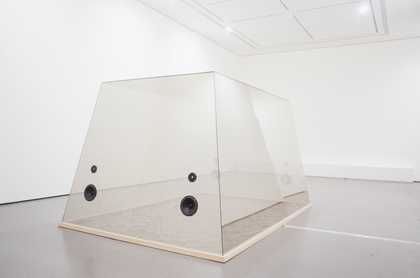Broken Memory
Since Portrait de famille (Family Portrait), 1991, I have been directing my attention towards a vast and perplexing field of investigation which embraces the questions of reproduction and heredity, of the origin of being. Through the medium of photography, I have been concentrating on the external image of beings, on fragments of bodies, on the skin, the human envelope. I have treated the skin as a sensitive surface which registers the marks made by time in the same way as photographic emulsion, which holds the image – or the image as a luminous wound on the emulsion. Skin as the frontier of the being, from the interior towards the exterior, the boundary between these two worlds, led me to look into the interior of the body. Scars, bruises, blood and tears are the reactions to suffering seen on the body.
The 1993 works, Rubis (Rubies) and Loin de moi et pres du lointain (Distant from me and near to the distance), represent the suffering located in the invisible parts of the body, in its fluids, in its genes, in the unquiet substances of the body. Penetrating the skin in this way brings me close to an important element that is present in the heart of the body: the voice. Perceptible, readable and audible in the 1983 Voices of Reason/Voices of Madness and the 1989 Hear me with your Eyes, I want to isolate the voice of the photographic image and make it exist in space. To give the voice back its body, from which it will escape, that body which can be heard both inside and outside its shell, both near and far in space. To create a body in the very image of space, a glass body.
The spectator who enters this installation should perceive space as the site of the projection of the voice, and at the same time understand the glass structure as being the origin of the voice. Glass as skin, the frontier between the exterior and the interior. Or even as the body of the voice.
– Genevieve Cadieux
Words to be Sung
Come out, come out, my anxieties;
stay not trammeled within by respect:
for to pay due tribute to affliction
one must lose all fear of pain.
Let sorrow emerge in full clamour,
for true grandeur to make itself known,
and to prove that insufferable anguish
can never remain unrevealed.
Let the mouth give vent to signals
of what is inflaming the heart,
for no one will believe in fire
without there be signs of smoke.
Do not allow discretion
to prevent the emergent cry;
for no great valiance has the captive
who breaks not the bonds of his cell.
He who respects his suffering
must not conceal what he feels;
he demeans the reason for his sorrow
if he does not express it with pride.
It is greater than I, my affliction;
and this being so, it is meet
that I should not try to subdue it,
but allow it to conquer me.
– Sister Juana Inés de la Cruz, 1651–1695
Genevieve Cadieux
Genevieve Cadieux is best known for her large-scale photographic works. These often focus on parts of the body such as eyes or lips and on things such as tears or bruises that might be seen as the external signs of internal suffering. Cadieux sees the body as a ‘sensitive surface capable of capturing and recording the fleeting passage of existence’.
Like tears or blood the human voice travels from the depths of the inside to the exterior of the body where it can express inner sensations. Unlike tears or blood, bruises or scars, voices are fugitive, impossible to pin down and to visualise. They nevertheless arrest us and linger in the memory, making of it a place of unrest.
In Broken Memory the surface is not the photographic emulsion that Cadieux’s previous work has accustomed us to. Instead it is the reflective mirror of the glass sheets that comprise this transparent tomb-like structure. Invisible, yet palpable, noises of distress tumble from the speakers to invade the gallery space, sometimes in an extended wail, at other times in bursts of almost intolerable emotion that ricochet off the bare walls. The sound is dense, almost primitive: separate from a real body or representation of it but nevertheless powerfully evoking a human presence.
Broken Memory was inspired by a poem by the seventeenth-century Mexican writer Sister Juana Inés de la Cruz in which the poet celebrates the display of grand emotion and the dignity of expressing intense pain or sorrow, believing that ‘insufferable anguish can never remain unrevealed’.
Text by Frances Morris, Curator, Modern Collection
‘Broken Memory’ text and poem translated by Barbara Wright

